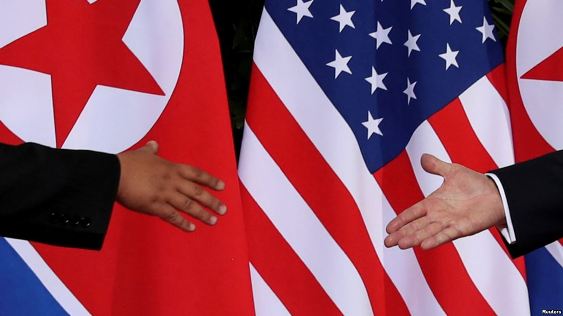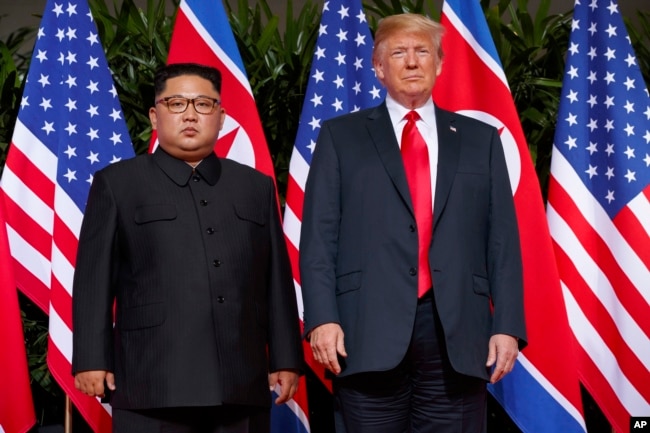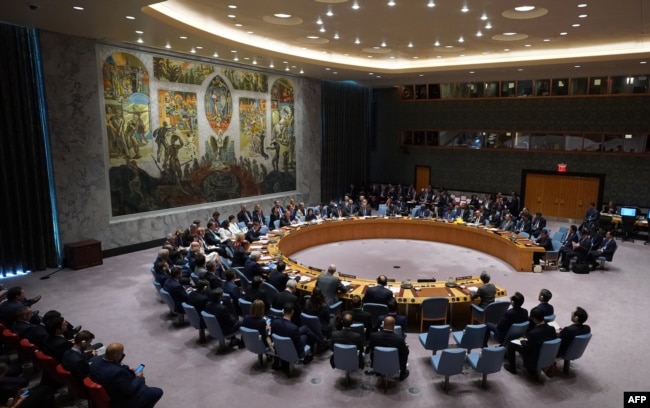A Complicated Path to Denuclearization as Trump-Kim Summit Nears

VOA News/Steve Miller
SEOUL — Despite the Trump administration asserting there’s been ongoing progress in talks with North Korea over its commitment to denuclearize, it is unclear what has been achieved ahead of the U.S. announced summit between President Trump and Kim Jong Un.
Bruce Klinger, Senior Research Fellow for Northeast Asia at the Heritage Foundation, says “that while some speculate that behind the scenes there had been quiet successes between the two sides, in reality, that really hasn’t been the case.”
North Korea’s denuclearization process has been stalled for months with little signs of outward progress, despite a call by South Korean President Moon Jae-in for Washington and Pyongyang to meet again. That’s something that is likely to take place before the end of February, when U.S. President Donald Trump said he’d meet North Korean leader Kim Jong Un for a second summit.
“A few days ago Vice President Pence said that [the U.S. is still waiting for North Korea to commit to denuclearization. That’s been consistent with the divergence between the U.S. and North Korean position, not only since last year’s summit but for decades,” said Klinger.
But, that may not be the case, says Rodger Baker, Vice President of Strategic Analysis for Stratfor.
“It seems that the North Koreans are the ones who have been driving the push for this second summit almost more so than the United States,” he said, referencing announcements in Kim Jong Un’s New Year’s speech which “laid out that North Korea saw a need for some change in behavior of the United States or else they would restart their program.”
“[North Korea] reached out to China to make sure that everything was going okay there and that China had their back, and then they reached out to the United States,” Baker assessed.
However, Harry Kazianis, director for Defense Studies at the Center for the National Interest, told VOA that at this point both sides may have realized there needs to be concrete progress towards denuclearization.
Kazianis said the “trick” now is to construct an interim deal “where both sides can come across as being a winner.”
“That’s a very hard thing to do at any sort of negotiation,” he said.
Trump met with North Korean nuclear envoy Kim Yong Chol for nearly two hours, saying the announcement of the location of the next summit would be made shortly and that Kim was looking forward to their meeting.
“We’ve made a lot of progress that has not been reported by the media but we have made a lot of progress as far as the new denuclearization is concerned,” he said.
Neither Trump nor the White House gave details about the talks.
Getting talks to move forward
When South Korean President Moon Jae-in met North Korean leader Kim Jong Un this past September in Pyongyang, “the North expressed its willingness to continue to take additional measures, such as the permanent dismantlement of the nuclear facilities in Yongbyon, as the United States takes corresponding measures in accordance with the spirit of the June 12 US-DPRK Joint Statement,” according to the joint declaration issued at the end of the summit.
Currently, what North Korea means by “corresponding measures” remains debatable among experts.
Kazianis suggests that one possible measure the United States could offer would be to make a formal peace declaration or begin the process to issue a peace treaty to formally end the 1950-1953 Korea War.
But Baker said that a peace declaration may not be sufficient.
“The United States has already made basically peace declarations or assertions of having no intent to attack North Korea, and that wasn’t enough,” said Baker.
Furthermore, Kazianis said, “The biggest thing that the North Koreans always talk about their propaganda media statements… is how afraid they are of America’s nuclear assets.”
He suggested that if Washington were to scale the assets back, “I think the North Koreans would be really, really incentivized to do a lot.”
Both Kazianis and Baker added that Pyongyang is also looking for sanction relief.
Although Klinger said many underestimate the complexity involved with reducing or eliminating sanctions, noting the difference between sanctions imposed by the United Nations and those by the United States.
“The U.N. sanctions are,” he said, “is sort of behavior modification, and a lot of the sanctions are trade restrictions, either import or export. In a way, those are more negotiable.”
“The U.S. sanctions are far more difficult to remove because they’re not just focused on the nuclear and missile programs. They are U.S. laws and they focus on human rights violations, criminal activities, such as money laundering, counterfeiting, as well as related to North Korea being on the state-sponsored terrorism list,” he said.
What needs to happen in February?
A criticism of previous summits between Kim and the leaders of South Korea and the United States has been the lack of concrete statements outlining how denuclearization will be achieved.
While Washington may still desire complete, verifiable denuclearization, Baker suggested that may not be “a viable and a realistic outcome anytime soon.”
“So the reality is that what the United States and North Korea and South Korea really are working towards is some way to manage North Korea and to find a way to ease a sense of imminent conflict,” he said.
Klinger said a key deliverable from the upcoming second U.S. – North Korean summit should be a commitment “to flesh out a comprehensive, integrated agreement which very clearly delineates everyone’s responsibilities.”
The problem he said, is that past agreements have been “short and vague enough that everyone can claim their own interpretation, and it doesn’t clearly identify what everyone has to do… and they all had very weak verification.”
Kazianis remains optimistic that the upcoming summit will make progress on the denuclearization front since both sides have a lot to offer in terms of concessions.
“For Trump to actually get a real concrete measurement on denuclearization would allow him to really get more buy-in to keep the process rolling in Washington and keep the people that are completely against this process on the left and the right, maybe to buy in a little bit more,” he said.
Neither Washington nor Pyongyang has yet to officially announce the date or location of the second U.S. – North Korean summit, although some speculate it may take place in Vietnam.



